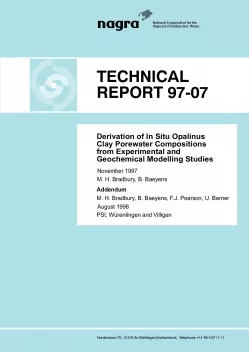
Technical Report NTB 97-07
Derivation of In Situ Opalinus Clay Porewater Compositions from Experimental and Geochemical Modelling Studies
Many countries are considering argillaceous sedimentary rocks as potential formations for the disposal of high level radioactive waste. One of the main attractions of such formations from a waste management viewpoint are their generally low groundwater flow rates. However, porewater chemistry constitutes an important basic data set for performance assessment studies and the low transmissivities often mean that it is very difficult, or even impossible, to obtain good in situ water samples. This report describes procedures based on physicochemical characterisation of whole rock samples and geochemical modelling which were developed as an additional tool for determining porewater compositions in low porosity/permeability clay rich systems. The methodology was applied to core samples of Opalinus clay within the framework of an international investigation being carried out at Mt. Terri, Canton Jura, Switzerland. The calculated porewater compositions are described and discussed in relation to experimental data from the analyses of borehole seepage water and water samples obtained from squeezing tests. Because the latter two waters were clearly out of equilibrium, only a comparison based on general aqueous features was attempted. In all three cases the groundwaters were high ionic strength Na-Cl types. The experimentally determined pH values were in the range 7.5 - 8 whereas for the modelled porewater a value near 6 was calculated. This discrepancy was explained by postulating that the sampled waters lost dissolved CO2 through out-gassing.
